
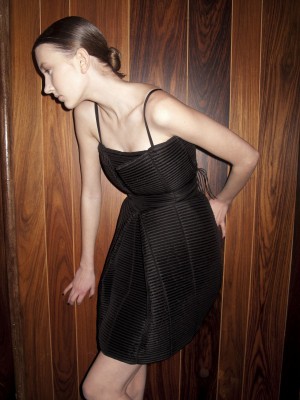
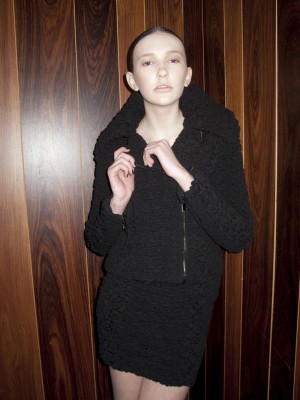
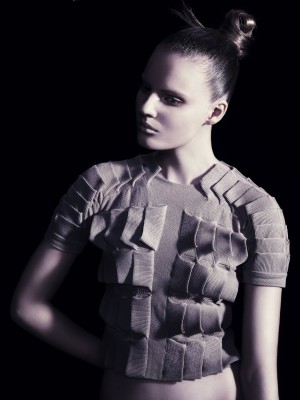
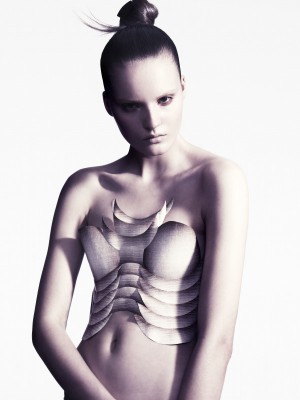
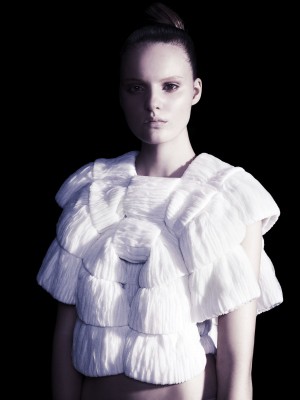
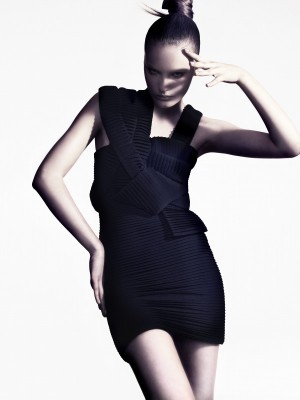
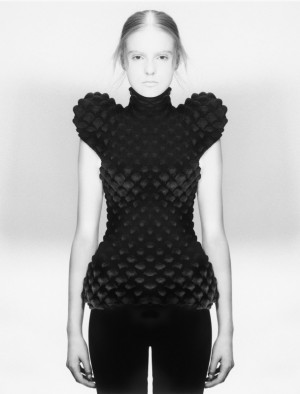

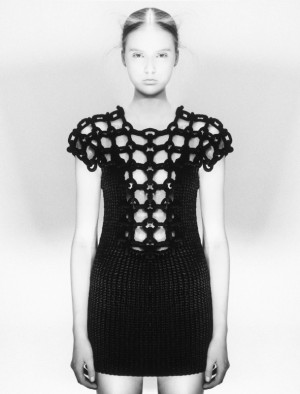
 “For me knitting is synonymous to creative freedom. I like the way you are building your own fabric while working and the way it is both mathematical and yet permits improvisation.”
“For me knitting is synonymous to creative freedom. I like the way you are building your own fabric while working and the way it is both mathematical and yet permits improvisation.”
-Can you explain about latest 10-11 A/W Collection?
The main thing that inspired me for the new collection is the same as usual, what goes on during my everyday struggles being a designer running my own company. The constant fight to find a balance between all the natural contradictions in fashion, the beautiful and ugly part of this business, but this time I decided to approach the knitwear more from a surface point of view. In a way you can say that I used fabrics to create garments with the typical Sandra Backlund knitwear volumes and silhouettes and used the knitting the way you normally cut and tailor fabrics.
-How did you come to establish the label? Have you ever thought work for another company before launching the label?
Already in fashion school I knew that I wanted to do my own thing and I founded my company and brand the first day after my graduation. Since I am so specialised in knitwear I get a lot of job offers in this field and I have done some free lance collaborations with other companies like Luis Vuitton and Emilio Pucci, but I have never yet considered to take a full time job anywhere els.
-Did you become a designer by accident or was it something that you always wanted?
I have always felt a strong connection to arts and crafts and a need to express myself in a creative way, but except from the artistic side of me I also have a strong theoretical and mathematical vein. My whole life I have had a lot of hard times trying to make these two opposites within myself co-operate. Through the kind of fashion that I do I finally found a way to combine both my free and my computing side.
-Why did you choose knitwear? What attracted you about knitwear design?
It was never my intention to figure out a thing to do that would make me a profile on something so specific. Actually I do not feel like I choose knitwear, it just happened that way. I have always been experimenting with different materials and three dimensional shapes and the kind of knitting that I do is just perfect for that. For me knitting is synonymous to creative freedom. I like the way you are building your own fabric while working and the way it is both mathematical and yet permits improvisation.
-Your work is sometimes described as sculpture or pieces of art. What do you think is the difference between art and fashion?
Personally I like to think of fashion as an art form rather then an industry, in a way you can see it as one of the most democratic art forms, something that most of us do relate to in our everyday life. People in general could of course be more self governed when it comes to fashion, but even if you do not think about it or actually care about it, the choices you make on what you wear is still an expression for something. It can be a personal or political statement, a way to become someone else or to blend in and look like everyone else or just because of aesthetical reasons. I can not stand the whole what is in and what is not conversation. If you like something you will know it, without anyone telling you to.
-How do you find and decide upon your themes for each season?
I am really introvert and lock myself in my studio when working on my ideas, so in that sense I guess I find inspiration from everything that is going on in my life. It could be very personal and deep or just common everyday struggles, it depends.
-Do you feel that brand concepts and seasonal themes are important in expressing a collection image?
I donВґt think much about that or try to analyse what I do in that sense, but of course everything from the philosophy, working process, language of shapes etc. comes together and creates the spirit and look of a collection.
-What do you place the most emphasis on in fashion design?
I can not single out one thing, for me it is everything mixed together that makes fashion so interesting.
-What are the sources of inspiration in your fashion design?
Except from the obvious, the techniques and the materials I work with, I am really fascinated by all the ways you can highlight, distort and transform the natural silhouette with clothes and accessories.
-Is there any designers or artists that had a strong influence of your work?
Not really, but I admire everyone with an own strong voice.
-Can you remember when you first started being interested in fashion? What was the trigger?
I donВґt know exactly when, but in the beginning I think it was just the lack of interesting fashion to buy as a teenager in stores in my hometown that made me create my own clothes. As an artist I choose fashion about ten years ago, before that I was more into art and photography.
-Tell me a bit about the Beckmans College of Design. What was it like studying there?
I was born in a town north of Sweden called Umea and moved to Stockholm ten years ago to start my education at Beckmans. I think it is a really good fashion school and during my four years there I learned a lot, both about what I like and what I am good at but also how I donВґt want to work with fashion. Working with the ideas and doing a real product, not just sketches, has always been my favourite part of the design process.
-What is your opinion on Scandinavian?
I think it is a mission impossible to try to narrow it down and describe the style of a whole region like that, but if I have to give it a try I would say that it is often simple and modern, but a bit safe.
-What do you think was the greatest turning point for you as a designer?
2004 – my graduate collection from Beckmans College of Design, 2007 – winning the grand jury price at Festival International De Mode & De Photographie in Hyeres, France, 2009 – starting my first small scale production in Italy and being able to offer my collection to buyers.
-What are the difficulties faced being a designer today?
It is a big responsibility to be working as a designer at this time and very difficult to state the reasons why you should be one of the people with the right to produce new things into a world in affluence. I like to believe that it is true that we can not live entirely on recycled things, but also need to be treated with new visions and stories told in the language of our time. What we need to realise though, is that the main problem today is that there is just too much of everything out there and that all of us with the mission to create new things have to remember to concentrate on what we are really good at and leave to others to do what they do best.
-How would you describe your own personal style?
I mostly dress in vintage one-of-a-kind pieces together with black or grey basics. For more special occasions I try to wear my own design.
-What does “Fashion” mean to you?
Right now, my whole life… besides of course my loved ones.
-What is your vision for the future?
I try to keep an open mind and not worry too much about the future. My plan is to continue to work hard, protect my origins and what I am good at, but still find ways to develop my designs and my company.
